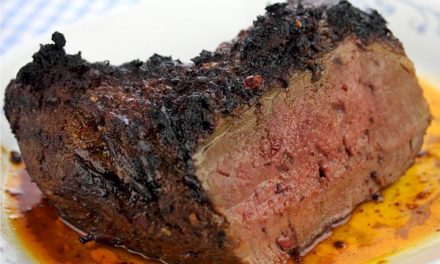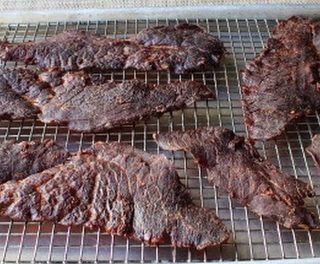This weekend I smoked a 7 pound pork shoulder. This to me is just about the most perfect lazy daddy meal for the weekend barbeque. It was good, it was fairly easy, and best of all, we have left overs so I’ve got my lunch all set for the next couple of days.
The equipment:
 I use an electric water smoker. I know that BBQ purists would be horrified as all the cooking shows I’ve seen talk about how the best smoking is done with charcoal. But let me tell you, my electric smoker plus a handful of hardwood hickory chunks gets the job done, and I can pretty much set it and forget about it for several hours on end (This is especially important for us dads with 3 year olds where we’d rather spend time tending our daughters than a hunk of meat).
I use an electric water smoker. I know that BBQ purists would be horrified as all the cooking shows I’ve seen talk about how the best smoking is done with charcoal. But let me tell you, my electric smoker plus a handful of hardwood hickory chunks gets the job done, and I can pretty much set it and forget about it for several hours on end (This is especially important for us dads with 3 year olds where we’d rather spend time tending our daughters than a hunk of meat).
 This weekend, we couldn’t find the hickory chunks, so my wife bought several hickory logs from the local butcher’s market where she got the meat and I used the electric chop saw to cut up my own chunks.
This weekend, we couldn’t find the hickory chunks, so my wife bought several hickory logs from the local butcher’s market where she got the meat and I used the electric chop saw to cut up my own chunks.
The last piece of equipment that I highly recommend would be heavy duty tinfoil. This should be used after the meat has been smoked for about 6-8 hours. At that point, you’re pretty much going to get all the smokey flavor you want into the cooked meat and the tinfoil helps lock in the juices so your meat doesn’t dry out.
The meat:
 Since my wife always teases me about how I go into professor mode, I’ll try to keep this brief, but I do want to point out that the origins of southern barbeque came from when the settlers brought pigs to the United States. These pigs were ideal to live in the southern climates whereas many of the cattle were ill-suited for survival. Because of this, you’ll find that most traditional southern dishes involve pork product more often than other meats (except of course fried chicken). Thus pork became the meat of the South. I’ve been told by friends that when people talk about true barbeque in the south, they mean pork and everything else is just grilled meat.
Since my wife always teases me about how I go into professor mode, I’ll try to keep this brief, but I do want to point out that the origins of southern barbeque came from when the settlers brought pigs to the United States. These pigs were ideal to live in the southern climates whereas many of the cattle were ill-suited for survival. Because of this, you’ll find that most traditional southern dishes involve pork product more often than other meats (except of course fried chicken). Thus pork became the meat of the South. I’ve been told by friends that when people talk about true barbeque in the south, they mean pork and everything else is just grilled meat.
 The pork shoulder is the entire front leg and shoulder of a hog. In your grocery store you will usually find this divided into two cuts, the Boston butt and the picnic.
The pork shoulder is the entire front leg and shoulder of a hog. In your grocery store you will usually find this divided into two cuts, the Boston butt and the picnic.
The Boston butt has less bone than the picnic and both cuts will weigh about 6 to 8 pounds. If you can’t find a whole pork shoulder at your local store you can get either or both of these cuts and have just what you need. The picnic can come with or without the bone. When cooking, I’ve found that the meat nearest the bone is the sweetest because of the extra flavoring and so I generally try to find a cut with the bone in.
We go to an actual butcher shop called Hottinger Family Meats, they’ve got a great selection and the meats are relatively hormone free. I haven’t done the research on their meat source but my wife has and so it’s a pretty safe bet that there’s not a lot of chemicals involved in raising these pigs.
The rub:
You can apply a rub to add flavor.
 If you choose to add a rub, do so liberally. We’ve generally had a lot of good luck with a paprika/brown sugar based dry rub that we make from the spices in our cabinet. I’d recommend you play with the recipe until you get it to a flavor that you enjoy. a good base to start with is the following:
If you choose to add a rub, do so liberally. We’ve generally had a lot of good luck with a paprika/brown sugar based dry rub that we make from the spices in our cabinet. I’d recommend you play with the recipe until you get it to a flavor that you enjoy. a good base to start with is the following:
- ¼ cup smoked paprika
- 3 tablespoons coarse salt
- 1 tablespoon garlic powder
- 1 tablespoon onion powder
- 3 tablespoon light brown sugar
Remember that you are trying to flavor a large piece of meat. To apply, take the pork shoulder or section, trim unnecessary fat and skin, rinse with cool water and pat dry. Take the rub and work it into the meat. Make sure that every part is evenly covered. Pork shoulders can have a very uneven surface with lots of folds and indentations so work it over well. Once you’ve got the meat covered in the rub, you’ll want to wrap it back up in plastic wrap and let it sit in the fridge for a couple hours (I recommend preparing the meat the night before so it’s all ready to go in the morning as you stumble out of bed to get the smoker going).
The smoking:
Under normal conditions you should plan on smoking for about 1-1/2 hours per pound. Low and slow is good, but realize that a ten-pound pork shoulder can take 15 hours to finish, so you’ll want to plan your day out to figure out when you’ll be eating dinner the night before. We started smoking our 7 pounder around 6:30 AM and were ready to eat around 6:00 PM (10 hours cooking, 1 hour resting, and half an hour pulling it apart and getting everything else ready).
 If it becomes difficult to maintain the temperature or you want to speed up the cooking time to get it to the table at a reasonable hour, you can always move it to the oven to finish cooking. If you do transfer the meat to the oven (and we have), set the temperature in 250-275 range, this will speed up cooking as smoking is generally done in the 210-235 range. However, make sure you wrap the pork tightly in foil to hold in the moisture. Many people, even competition cooks, will smoke their pork roasts unwrapped for half the overall cooking time and then wrap.
If it becomes difficult to maintain the temperature or you want to speed up the cooking time to get it to the table at a reasonable hour, you can always move it to the oven to finish cooking. If you do transfer the meat to the oven (and we have), set the temperature in 250-275 range, this will speed up cooking as smoking is generally done in the 210-235 range. However, make sure you wrap the pork tightly in foil to hold in the moisture. Many people, even competition cooks, will smoke their pork roasts unwrapped for half the overall cooking time and then wrap.
Remember though, leave the pork in the smoker for at least 6 hours if you want to get that good smokey flavor – and the lower and slower you cook your meat the more tender it will be when it reaches the dinner table.
 Once the meat reaches an internal temperature between 180 F to 190 F it is done cooking and must rest before pulling. Technically you can serve pork once the internal temperature reaches 165 – but you miss out on all that breaking down of collagen and connective tissue that makes the barbeque so darn tender and juicy.
Once the meat reaches an internal temperature between 180 F to 190 F it is done cooking and must rest before pulling. Technically you can serve pork once the internal temperature reaches 165 – but you miss out on all that breaking down of collagen and connective tissue that makes the barbeque so darn tender and juicy.
Typically you can pull the meat easily once the internal temperature reaches 190 degrees F, but you don’t want to go above this and the higher the temperature goes the greater the chance it will dry out.
Once the pork is cooked remove it from the smoker (or oven) and let it sit for about an hour. This will cool it down enough for pulling. As you pull the meat apart, place it in a pot on a low temperature to keep it warm. You want it to be loose in the bun and easy to eat. Now if the pork is smoked right it won’t be chewy in the least.
The finishing sauce:
The traditional sauce for pulled pork is what is commonly called a finishing sauce. We’ve served finishing sauces based on a vinegar recipe, but I’m tempted to go with a thicker tomato base next time just for a little contrast (Or maybe even whip out the teriyaki sauce that I’m such a huge fan of). I could recommend half a dozen different finishing sauces, but I’ll leave this up to you as people’s taste are so varied on the subject. I may post some links to some outstanding finishing sauces that I like later, but I honestly love the taste of the pork without the finishing sauce too. After spending 10-15 hours prepping and smoking this meat, why cover the flavors?
The sandwich:
 You don’t need fancy or flavorful bread for this sandwich. All the bread does is give you something to hold onto while you’re eating the meat. So put those onion rolls, poppy kaisers and Hawaiian rolls away (Actually, the Hawaiian rolls with a teriyaki finishing sauce might be interesting if you’re going for a luau theme – but it’s not “Southern”) . For our family, we generally use the 3 inch by 3 inch buns you can get from WinCo Foods bakery. Cheap, good and we can get 24 rolls for $2.99.
You don’t need fancy or flavorful bread for this sandwich. All the bread does is give you something to hold onto while you’re eating the meat. So put those onion rolls, poppy kaisers and Hawaiian rolls away (Actually, the Hawaiian rolls with a teriyaki finishing sauce might be interesting if you’re going for a luau theme – but it’s not “Southern”) . For our family, we generally use the 3 inch by 3 inch buns you can get from WinCo Foods bakery. Cheap, good and we can get 24 rolls for $2.99.
I’ll generally use only a few condiments, including cheese (again, WinCo carries a great garlic Monterey jack cheese) the vinegar finishing sauce, cole slaw and sometimes mayonnaise.
Enjoy:
You’ve “worked hard” all day preparing this meal. Make sure to invite a few friends over, have them bring the kids and the adults can all hang out in the backyard with a beer or two while the kids play (We actually made espresso/mocha/lattes with our new portable espresso maker from REI, but that’s a post for another time).




